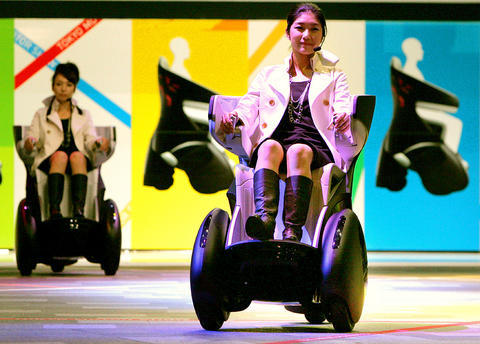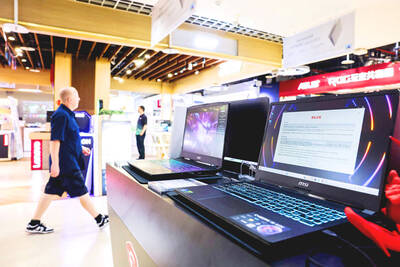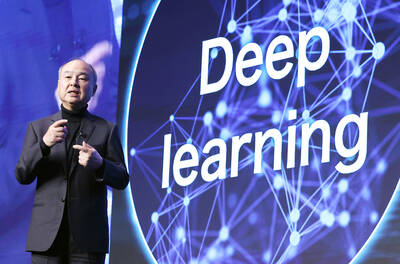Toyota is getting philosophical and exploring its Japanese roots at the Tokyo Motor Show, which opens later this month.
A single-seat vehicle packed with sensors and a car designed to blend harmoniously with nature are among the futuristic-looking "concept," or experimental, models Toyota Motor Corp is readying for the biannual exhibition opening to the public on Oct. 27. Reporters got a sneak peek of several models that will be on display.
The show, which draws automakers from around the world, tends to have more whimsical offerings than the more practical products on display at other shows.

PHOTO: AP
Toyota general manager Tetsuya Kaida said the Japanese automaker wanted to show how it was different from its US and European rivals and found inspiration from Japan's ancient arts that emphasize Zen-like spirituality.
"This is about the Way of the Car, much like tea ceremony and flower arrangement," he said at a recent preview.
Kaida said cars are starting to be seen by some as a nuisance, causing pollution, traffic accidents, noise and global warming.
Instead, cars must become gentler and more friendly, offering value to people's minds and sensibilities, he said.
To tackle such challenges, the automaker should fall back on its Japanese culture, which emphasizes a subdued aesthetic, including harmony with nature, Kaida said.
A toylike green-and-beige model called Rin, which means "upright" and "graceful," has a transparent floor, huge windows and doors that slide open like Japanese shoji screens so its interior appears to blend with its surroundings for what Toyota called a soothing ride. Its beige seating enhances passengers' skin tones, and the seats are designed to improve posture, Toyota said.
"This car is about a beautiful and healthy mind,'' says Satoru Taniguchi, who oversees Rin, a plug-in gas-electric hybrid.
The I-Real, another model, is Japanese in a different way, boasting the nation's robotics technology.
It looks like a roofless plush armchair that scoots about on wheels, with buttons and controls on the arms. It changes positions, straightening up to move slowly among pedestrians or laying back to travel faster at up to 30kph.
Another offbeat model expected to be on display was a plug-in hybrid sport-utility vehicle (SUV), "Hi-CT," which stands for "hi ride city truck," that resembled a bulky cube, and Toyota said it was inspired by the form of a gorilla.
Chiharu Tamura, a Toyota manager, said that was an effort at redefining "Japanese cool" to appeal to youngsters.
Ironically, Europeans did some of the SUV's design.
Tamura said that preconceptions about cars being slinky and symmetrical were obsolete.
"This is a rugged kind of cool," he said. "It's different from other cars."
In addition to Toyota's Rin, Honda's Puyo and Nissan's Pivo 2 seem to be inspired more by the iPod, futuristic space capsules and manga publications.
Honda Motor Co says its white bubble-shaped rubbery-surfaced Puyo, equipped with a panoramic window, is supposed to be a pet. The cabin part of Puyo, a fuel-cell vehicle, rotates so it never has to go into reverse.
Honda compared the aesthetics of Puyo, whose name is based on the Japanese word that describes floating or soft objects, to cute things like a bunny and balloon.
The cabin of Nissan's Pivo 2, an electric vehicle, can rotate on its wheel base so that it can face the opposite direction. The vehicle's tires can also turn 90 degress, allowing it to move sideways into tight spaces.

IN THE AIR: While most companies said they were committed to North American operations, some added that production and costs would depend on the outcome of a US trade probe Leading local contract electronics makers Wistron Corp (緯創), Quanta Computer Inc (廣達), Inventec Corp (英業達) and Compal Electronics Inc (仁寶) are to maintain their North American expansion plans, despite Washington’s 20 percent tariff on Taiwanese goods. Wistron said it has long maintained a presence in the US, while distributing production across Taiwan, North America, Southeast Asia and Europe. The company is in talks with customers to align capacity with their site preferences, a company official told the Taipei Times by telephone on Friday. The company is still in talks with clients over who would bear the tariff costs, with the outcome pending further

A proposed 100 percent tariff on chip imports announced by US President Donald Trump could shift more of Taiwan’s semiconductor production overseas, a Taiwan Institute of Economic Research (TIER) researcher said yesterday. Trump’s tariff policy will accelerate the global semiconductor industry’s pace to establish roots in the US, leading to higher supply chain costs and ultimately raising prices of consumer electronics and creating uncertainty for future market demand, Arisa Liu (劉佩真) at the institute’s Taiwan Industry Economics Database said in a telephone interview. Trump’s move signals his intention to "restore the glory of the US semiconductor industry," Liu noted, saying that

STILL UNCLEAR: Several aspects of the policy still need to be clarified, such as whether the exemptions would expand to related products, PwC Taiwan warned The TAIEX surged yesterday, led by gains in Taiwan Semiconductor Manufacturing Co (TSMC, 台積電), after US President Donald Trump announced a sweeping 100 percent tariff on imported semiconductors — while exempting companies operating or building plants in the US, which includes TSMC. The benchmark index jumped 556.41 points, or 2.37 percent, to close at 24,003.77, breaching the 24,000-point level and hitting its highest close this year, Taiwan Stock Exchange (TWSE) data showed. TSMC rose NT$55, or 4.89 percent, to close at a record NT$1,180, as the company is already investing heavily in a multibillion-dollar plant in Arizona that led investors to assume

AI: Softbank’s stake increases in Nvidia and TSMC reflect Masayoshi Son’s effort to gain a foothold in key nodes of the AI value chain, from chip design to data infrastructure Softbank Group Corp is building up stakes in Nvidia Corp and Taiwan Semiconductor Manufacturing Co (TSMC, 台積電), the latest reflection of founder Masayoshi Son’s focus on the tools and hardware underpinning artificial intelligence (AI). The Japanese technology investor raised its stake in Nvidia to about US$3 billion by the end of March, up from US$1 billion in the prior quarter, regulatory filings showed. It bought about US$330 million worth of TSMC shares and US$170 million in Oracle Corp, they showed. Softbank’s signature Vision Fund has also monetized almost US$2 billion of public and private assets in the first half of this year,